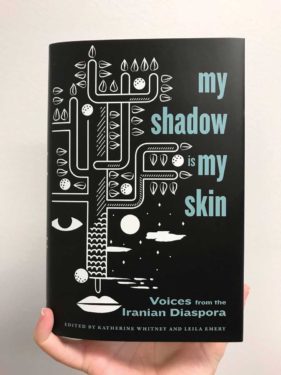By Ali Sahebalzamani
 My Shadow is My Skin: Voices from the Iranian Diaspora is a collection of essays organized and edited by Katherine Whitney and Leila Emery and published by the University of Texas Press. Thirty-two writers, including the editors themselves, contributed to the collection. The writers are all first- or second-generation Iranian immigrants to the United States. This book is not a singular entity; rather it is a patchwork or quilt that, once read from cover to cover, resolves into an image that still, nevertheless, cannot be considered a singular creature. The title of the book is taken from a line in the third essay of the collection, “Shadow Nation,” written by Cyrus Copeland, which is arguably one of the best pieces. The central idea of the collection is that identity, especially multi-cultural identity such as the Iranian-American one, can only exist inside the medium of the story; in this case, the story of the diaspora repeated in the lives of the individuals belonging to said diaspora. As one reads further through the collection, glorification of the medium becomes ever more perceptible; storytelling, already beyond mere entertainment, surpasses even its intended role as the vessel for the cultural identity of the Iranian diaspora—it becomes akin to a patron deity, or saint, for these lost, exiled souls set adrift by revolution and war.
My Shadow is My Skin: Voices from the Iranian Diaspora is a collection of essays organized and edited by Katherine Whitney and Leila Emery and published by the University of Texas Press. Thirty-two writers, including the editors themselves, contributed to the collection. The writers are all first- or second-generation Iranian immigrants to the United States. This book is not a singular entity; rather it is a patchwork or quilt that, once read from cover to cover, resolves into an image that still, nevertheless, cannot be considered a singular creature. The title of the book is taken from a line in the third essay of the collection, “Shadow Nation,” written by Cyrus Copeland, which is arguably one of the best pieces. The central idea of the collection is that identity, especially multi-cultural identity such as the Iranian-American one, can only exist inside the medium of the story; in this case, the story of the diaspora repeated in the lives of the individuals belonging to said diaspora. As one reads further through the collection, glorification of the medium becomes ever more perceptible; storytelling, already beyond mere entertainment, surpasses even its intended role as the vessel for the cultural identity of the Iranian diaspora—it becomes akin to a patron deity, or saint, for these lost, exiled souls set adrift by revolution and war.
Many of these essays are in fact, short stories—non-fiction slices from some of the most intimate nooks and crannies of the writer’s own life, rendered in shocking detail and with disarming sincerity. Most of the writers emigrated from Iran some time during the 1980s which, understandably, “…was not the best time to be an Iranian living in America… .” This phrase, or something similar, is repeated throughout the collection to the point of monotonousness and it does get the intended point across. From the very first piece, written by Jasmin Darznik, the reader is bombarded by tales of hardship, discrimination, struggle, and even violence, punctuated by other, less bitter stories, such as an American mother’s endeavors to ensure her children’s familiarity with their father’s Iranian heritage in “Mothering Across the Cultural Divide” by Katherine Whitney. Another piece, “Silkscreen” by Omid Fallahazad, tells the story of an Iranian couple living in America on green cards which, in the America of Donald Trump, must govern their passions very carefully, with the protagonist railing against the activism of his wife in a narrative that seems male chauvinistic to the eyes of their American friend. The dynamic of the husband-wife relationship and how it is affected by the political climate, against the backdrop of trauma sustained in Iran during the eighties, is truly a delight to read. Then there are a few of the pieces, such as “Sacrifices” by Iraj Isaac Rahim, where painful and traumatic events are retold through the medium of humor. Another piece that utilizes humor to aid in the digestion of the immigrant experience is “The Name on My Coffee Cup” by Saïd Sayrafiezadeh, resulting in a splendidly mischievous tale.
The essays are organized into three thematic categories: the first section, “Light/Shadow,” deals with themes of secrecy and shame as the writers reveal their struggles with traditional-minded parents or an unwelcoming host community that saw Iranians as foe. Within the second section, “Coding/Decoding,” the so-called hyphenated living is discussed as the contributors describe their ordeals in navigating the abyss between the two oft-conflicting cultures. Finally, the third section, “Memory/Longing,” is dedicated to a sort of reminiscence on Iranian heritage, seeing the old country in the rearview and longing for it, as the writers examine, rather romantically, the Iranian bits they have stuck unto their souls.
Some of the essays give in to victim culture rhetoric and even descend into self-pity, yet the whole image remains untarnished as, through the tactful ordering of the pieces by the editors, those few stories, which can be counted on the fingers of one hand, are placed in between the others in a way that does not compromise the integrity of the collection or in any way ruin the reading experience. There are also the ever-present misspelled names—such as that of foods and confectionaries—and the clumsy, ill-executed attempts at writing Persian dialogue in English that certainly could have been avoided. Perhaps the contributors could have done more research before submitting their pieces. How difficult could it be, after all, to ask a Farsi-savvy relative or friend how a particular sentence is actually spoken.
If someone were to ask me who is the ideal audience for this book, I wouldn’t be able to tell; on the one hand there are more recent generations of immigrants, myself included, who merely got on a plane and came to America where we were greeted by natives who are used to seeing brown people in their midst, whereas the previous generations of immigrants were not so fortunate. The thought of being an Iranian living in America during the hostage crisis sets my teeth on edge. On the other hand, the insight provided by most of these pieces would certainly be eye-opening to non-immigrants. Then, of course, there are those whose own experience might be reflected in these writings which doubtless would find some solace in the knowledge that they did not struggle alone. All in all, through noble endeavors such as the compiling of this collection, one can say it is a good time to be an Iranian in exile.


















